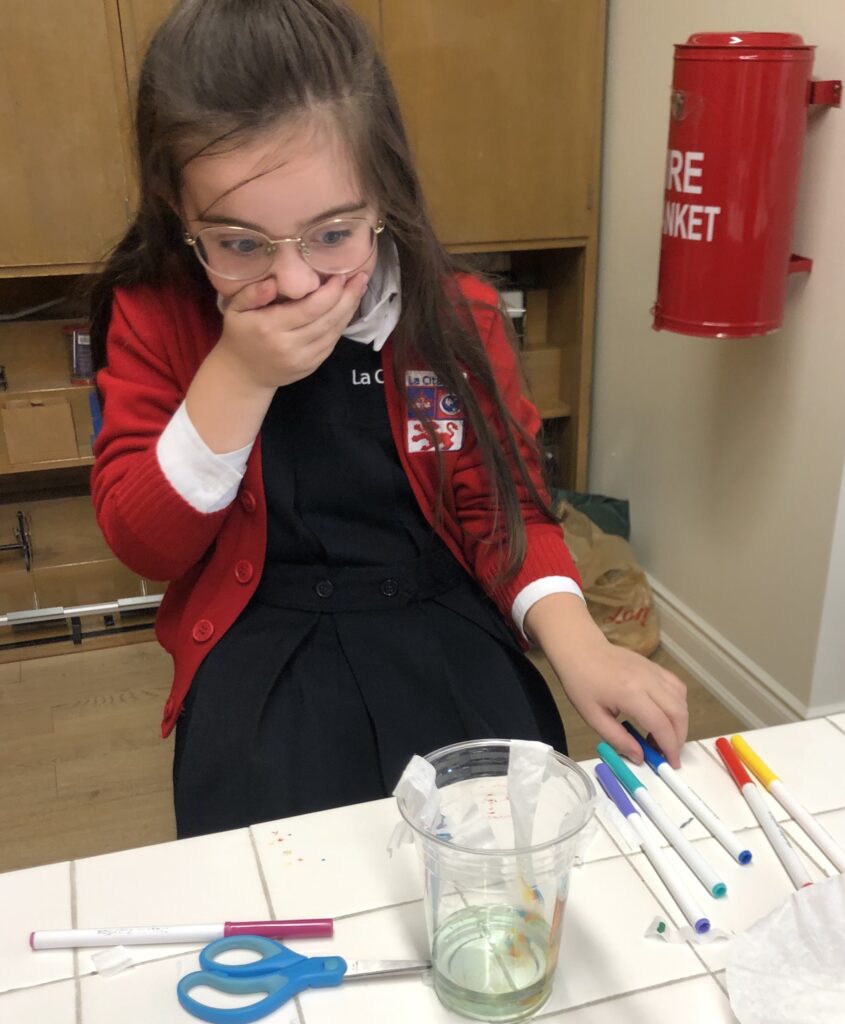Optics are how we see things. Our eyes can see beautiful things and we can create them too! In this series of workshops, we will mix colours to obtain new ones and understand that black is not black! We will make paintings using chemistry and trick our eyes into seeing things that are not. We will explore the properties of light and water while creating artistic pieces and much more!


In the realm of dynamic art, where Science, Technology, Engineering, Art, and Mathematics (STEAM) intersect, the concept of artwork in motion has been extensively explored, notably by the renowned artist nicknamed “Agam”.
He pioneered an innovative approach where the artwork transforms based on the viewer’s position, thus creating an interactive visual experience. In our workshop, we harness this idea to craft our own dual artwork, presenting two distinct perspectives from two juxtaposed drawings. Alongside artistic exploration, we delve into STEAM concepts by decomposing light to create an indoor rainbow and recombining colors through mixing rainbow hues. This integration of art and science fosters a holistic understanding of creativity and scientific principles.
From a simple drawing, we will perform some “magic”, combining colors to create a stunning visual effect of a white hue. This playful experience will illustrate how we can fool our eyes to see colours others than what they are.
From a simple drawing, we will perform some “magic”, combining colors to create a stunning visual effect of a white hue. This playful experience will illustrate how colors blend and interact, providing a fascinating insight into additive color synthesis.
Chemistry to make art? Shaving cream to make modern patterns? This is what will do in this series of experiments that combine art and chemistry!

Budding scientists will be passionate about chemistry in this workshop that combines arts and sciences! Young artists enthusiastically experiment with various products with unique chemical properties; colourful and amazing reactions come to life under their creative fingers, transforming the space into an artistic laboratory. Children discover the magical marriage of science and art while creating their personalized masterpieces. From colorful bubbles to spectacular effects, each experiment encourages curiosity, stimulates creativity, and provides a artistic perspective on the magic of chemical and physical reactions.
If we mix primary colours, we obtain secondary colours. But, can colours mix on their own by “climbing” on paper? That’s what we will explore in this enchanted and colourful experiment!

In our STEAM-infused art laboratory, we embark on a fascinating experiment to create a liquid rainbow. Building on the principle that primary colors, when mixed, yield secondary colors, we delve into an intriguing question: can colors blend on their own as they “climb” on paper? As the solutions travel and converge, they recombine into a dazzling spectrum of secondary colors. This enchanting and colorful experiment provides a captivating glimpse into the fusion of art and science, urging us to further explore the mysteries of color and transformation.
Creating colours from a simple black dot? It’s not magic; it’s chromatography! This is what we will do in this remarkable experiment.

A surprising workshop that immerses us in the world of chromatography to demystify the secrets of colors hidden in a simple black marker! With a clever technique, let’s discover how pigments move magically on paper in the presence of a solvent. Let’s marvel at the different shades of the marker separating into artistic bands of colors, revealing the secrets of colors. This interactive experience is a true colorful adventure that takes us exploring the wonders of the science of colors.
Take an image, two artistic techniques, a bit of luminosity and transparancy, and voila… two unique art pieces! Light plays tricks on us!

Let’s explore two fascinating art techniques: collage and stained glass. Let’s discover how these methods use light and transparency differently. With collage, let’s play with contrasts and textures to create unique compositions. On the other hand, stained glass will allow us to experiment with light refraction and color interplay through pieces of colored paper. It’s an artistic exploration that combines creativity and optical concepts.
What is density? Does it have to do something with weight? Let’s test this phenomenon with a solute in a solvent.

What is density? Does it have to do with mass? Let’s study this phenomenon by creating a multicolored cocktail of solute dissolved in a solvent. In this liquid science workshop, young scientists will prepare solutions of different densities and create their own multicolored density column in test tubes! They will learn to use pipettes, calculate concentrations of different solutions, and establish the relationship between concentration and density. They will form distinct layers of coloured solutions based on their respective densities and take on the challenge of recreating a rainbow of gradual densities. Children understand that the densest solution sinks in the test tube while the least dense one floats. This workshop offers a hands-on experience where scientific principles are explained with a light approach in French.
What is a kaleidoscope? An optical illusion? Magic? Art? Actually, it is a little bit all these things. We will solve this mystery by each making our own decorated instrument.

What is a kaleidoscope? An optical illusion? Magic? Art? In fact, it’s a bit of all that. It’s an instrument developed over 200 years ago that uses the reflection of light on mirrors to create enchanting repetitive patterns. In this workshop, children will make their own kaleidoscope and are introduced to the terms reflection and refraction of light while being captivated by the physics of the shimmering patterns on reflective surfaces. This simple yet captivating play of light was used as a tool for prestidigitation in the 19th century because of its fascinating nature.
What is the use of paper? Write words, make paper airplanes, write books, copy our schoolwork, yes… and much more! Today, we’re making art with coloured paper rolls!